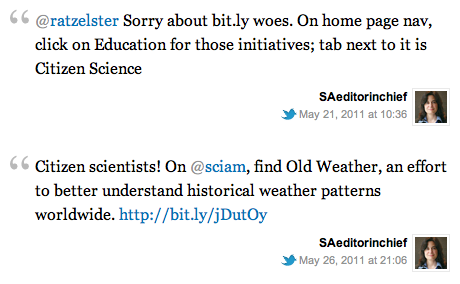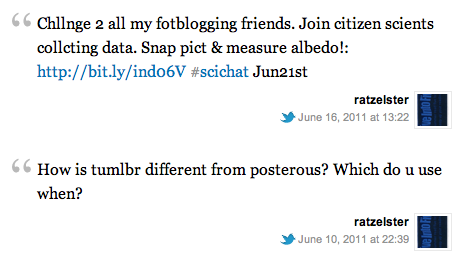 Ever wish Twitter provided a more coherent narrative? This tale of science adventure is being told both to underscore the value of Personal Learning Networks and to demo the power of Storify. Storify helps you assemble disparate tweets, pictures, retweets, responses to tweets and direct messages into one place — and one storyline. Add narration and extra information to the Twitter content, and you now have a chance to tell a tale and help others understand what happened. Here’s how mine came out.
Ever wish Twitter provided a more coherent narrative? This tale of science adventure is being told both to underscore the value of Personal Learning Networks and to demo the power of Storify. Storify helps you assemble disparate tweets, pictures, retweets, responses to tweets and direct messages into one place — and one storyline. Add narration and extra information to the Twitter content, and you now have a chance to tell a tale and help others understand what happened. Here’s how mine came out.
So I was hunting for age appropriate reading for my 6th graders and happened across a Tweet by the editor of Scientific American explaining how Scientific American was reaching out to K12 students.
Who could imagine someone as science-connected as this editor would take the time to talk to a middle school science teacher? I stand in awe of the power of social media to connect people who are passionate about the same thing. In this case: finding ways to inspire students to become scientists.
I will be forever grateful to her help, and I wonder if she’ll ever know what an impact she is going to have on years and years of student learning?
I loved this Old Weather project where citizens helps scientists read thru ship logs and transcribe the handwritten journals into digital forms. There are amazing videos here from the scientists describing exactly how they will use all this data that citizens are producing.
They really make you feel like your role in helping is a critical and vital one to their projects. It seems that K12 school teachers aren’t the only ones having time and money woes.
It wasn’t long after these exchanges that I read about this idea of Citizen Science in other publications. Seems that I’d been asleep to all the possibilities that longstanding projects like the Science Friday Initiative offer to science teachers like me.
Good thing I’m getting up to speed now!
Someone in my Twitter network read about my initial talks and had done her own research at the Citizen Science site. She suggested another project she had found.
We both agree that this Mastadon Matrix soil study is a winner. Sure to resonant with our students and a do-able kind of science for 11 and 12 year olds.
So the mastodon project is a definite go. Students will love this idea and it will draw them right into thinking and believing that science is something you do….not something you read about.
I still felt like I needed to do some of the real science and some noodling around with the projects before school restarts. I joined the Old Weather project and have been doggedly transcribing these awesome old weather journals from ships.
And most people thought only social studies students got to work with primary sources. Ha!!! Little did they know (or did I know) that the history of science (much of it in primary sources) can lead us to discover a great deal about the climate and weather of those times….from real-time observations from ships all over the globe.
I also joined the robin project at Science for Citizens and helped by finding, observing and photographing robins in my yard. It’s fun and easy to do.
Next the blog suggested that I could easily help out with monitoring the amount of heat that’s retained by the earth (albedo)….a measurement of changing climates and weather. Take one picture on one day and you help collect loads of data for scientists.
Another one of my self-study topics for the summer was photoblogging. I challenged myself to take and upload one image each day of the summer. One of the JJAProject members saw my albedo post and suggested that it might be a great thing for our whole group to do on June 21st.
What a great idea. What a fabulous way to use a network of interested people from all over!!! Talk about the power of social networking.
So I got on the bandwagon and sent out a challenge to all my Twittering friends to take a photo for the Citizen Science project.
Sure enough…they responded and are up for the challenge.
Isn’t this story an amazing treasure hunt? For me, it really shows what one tweet can do to change the lives of so many people –and potentially even more when school resumes and all of us teachers go back to work. You can be sure many of us will be using these ideas we’ve tested. We’ll try them out in our classes and maybe we’ll be Storifying our tweets again as we report on the results.
And so goes. The twitter treasure hunt for engaging, on-target student projects never ends. And the power of one is alive and well — with help from tools like Storify and the amazing Twitter.
NOTE: I’ve tried to duplicate the “look” of Storify here, but you can also see the original to get the exact feel of Storify and how it puts it all together. Also, the links in the tweets are live there.
Marsha Ratzel
Latest posts by Marsha Ratzel (see all)
- Scaffolding Quadratics: 2 Things My 8th Graders Taught Me with Student Feedback - May 20, 2019
- Student-Driven Common Core Classrooms - February 14, 2013
- Shifting toward PBL in Math - December 6, 2012













This is an absolutely WONDERFUL story! Thanks for sharing it! It makes me so excited to see a teacher thrilled about educating her students!
I have one question, though. Why do educators think that teacher go back to work only when school resumes? I am thinking that your connection of the “dots” of projects that twitter gave to you is a perfect example of how educators should work during “vacation” time. Educators truly should hone and reflect upon their lessons during this “down” time.
That being said, it is SO wonderful to share your passion and love of learning and connecting dots!
Just a follow up note…..the Albedo project is running again on August 5th, so join up if you can. It was easy and so simple to execute.
Another project the Mastadon Matrix Project http://scienceforcitizens.net/project/250/ seems like another project that is very engaging for students…the scientists are very kind to help you get started, have wonderful guiding lesson plans…..and takes them back to the thing they all love….DINOSAURS. I don’t think it matters how old they are, almost everyone in K12 loves prehistoric animals.
My Twitter buddy, Janelle Wilson, and I have been making plans to do this in the fall. I’m sure we’ll be tweeting up a storm—sharing info back and forth.
I’ve just sent a link to your blog off to our Science Dept. Head who is very interested in students “doing” science. Thank you for the wonderful and helpful narrative. Not only does it demonstrate the usefulness of Storify, but the resources are terrific! Our Lower School science teacher will love the opportunities for hands-on, authentic learning you’ve provided!
I was excited to find out more about Citizen Science — and esp. the Old Weather ship logs project. I’m signing up before all the fun is over.
http://www.oldweather.org/
This may not *seem* like fun to everyone, but if you’ve read all the Patrick O’Brian novels twice…it’s versamilitude.
Also can’t wait to play around with Storify.
Marsha,
What a great tail. I love the Citizen Science idea and will share with my science colleagues. What I really like though is gathering stories about ordinary teachers finding success and help through twitter.